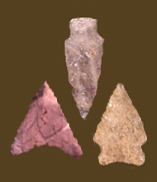
|
BREWERTON EARED NOTCHED Defining Attributes Chronology Most authorities feel the four point types of the Brewerton Complex were contemporary, although Ritchie (1971) suggests the Side Notched was the oldest. Custer (1996b) places the start of the Brewerton Complex around 4300 BC (calendar) and continuing to perhaps 1600 BC. Justice (1987) suggests a range of 4930 to 3673 BP (approximately 3700-2050 BC calendar), while Funk (1993) suggests 5150 to 4450 BP (approximately 3950-3100 BC calendar) for the Brewerton Complex in the Upper Susquehanna Valley. Description Haft Element: The broad stem has small, shallow, often v-shaped side notches. The base is expanded, ending in small, well-made, rounded or sharp ears. It is usually concave, but can be straight. The ears and base can be ground. Size: Length ranges from 19 to 64 mm, with most between 25 and 38 mm. Width ranges from 19 to 29 mm, with an average of 23 mm. Thickness ranges from 5 to 9 mm, with most around 6 mm. Technique of manufacture: Carefully made by pressure flaking. Material: In a sample of 31 Brewerton Eared Notched points from the lower Patuxent drainage, Steponaitis (1980) reported that 29% were quartz and 29% quartzite, followed by rhyolite (26%) and chert (16%). In the area surrounding Zekiah Swamp on the lower Potomac, Wanser (1982) found that 72% of 46 Brewerton Eared Notched points were quartz, with 26% quartzite, and 2% chert. At the Higgins site in Anne Arundel County, all four Brewerton Eared Notched points were quartz (Ebright 1992). In the Monocacy River drainage, 93% of 54 Brewerton Eared Notched points were rhyolite and 7% jasper (Kavanagh 1982). An argillite Brewerton Ear Notched point was reported from the Pine Valley Park site in Carroll County, Maryland (Israel 2008). Discussion Ritchie (1971) suggests the Eared Notched point developed from the Brewerton Side Notched in the late Middle Archaic period. Justice (1987) considers the Brewerton Eared Notched to be a variant of the Brewerton Eared Triangle point, with the Eared Triangle generally wider and thinner than Eared Notched points of the same length, which may be a reflection of the amount of re-sharpening on examples of the two types. Defined in Literature References |
![]()
Search by Shape:
(See Projectile Point Typology) |

|
Thank you for visiting our website. If you have any
questions, comments, Copyright © 2002 by |

|

